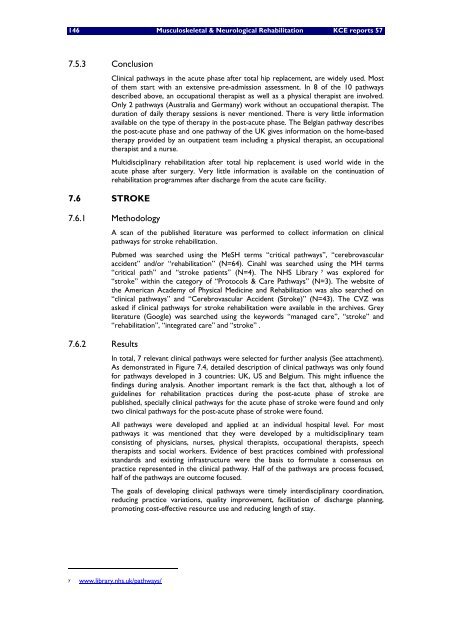The report is available in English with a French summary - KCE
The report is available in English with a French summary - KCE
The report is available in English with a French summary - KCE
Create successful ePaper yourself
Turn your PDF publications into a flip-book with our unique Google optimized e-Paper software.
146 Musculoskeletal & Neurological Rehabilitation <strong>KCE</strong> <strong>report</strong>s 57<br />
7.5.3 Conclusion<br />
Cl<strong>in</strong>ical pathways <strong>in</strong> the acute phase after total hip replacement, are widely used. Most<br />
of them start <strong>with</strong> an extensive pre-adm<strong>is</strong>sion assessment. In 8 of the 10 pathways<br />
described above, an occupational therap<strong>is</strong>t as well as a physical therap<strong>is</strong>t are <strong>in</strong>volved.<br />
Only 2 pathways (Australia and Germany) work <strong>with</strong>out an occupational therap<strong>is</strong>t. <strong>The</strong><br />
duration of daily therapy sessions <strong>is</strong> never mentioned. <strong>The</strong>re <strong>is</strong> very little <strong>in</strong>formation<br />
<strong>available</strong> on the type of therapy <strong>in</strong> the post-acute phase. <strong>The</strong> Belgian pathway describes<br />
the post-acute phase and one pathway of the UK gives <strong>in</strong>formation on the home-based<br />
therapy provided by an outpatient team <strong>in</strong>clud<strong>in</strong>g a physical therap<strong>is</strong>t, an occupational<br />
therap<strong>is</strong>t and a nurse.<br />
Multid<strong>is</strong>cipl<strong>in</strong>ary rehabilitation after total hip replacement <strong>is</strong> used world wide <strong>in</strong> the<br />
acute phase after surgery. Very little <strong>in</strong>formation <strong>is</strong> <strong>available</strong> on the cont<strong>in</strong>uation of<br />
rehabilitation programmes after d<strong>is</strong>charge from the acute care facility.<br />
7.6 STROKE<br />
7.6.1 Methodology<br />
7.6.2 Results<br />
A scan of the publ<strong>is</strong>hed literature was performed to collect <strong>in</strong>formation on cl<strong>in</strong>ical<br />
pathways for stroke rehabilitation.<br />
Pubmed was searched us<strong>in</strong>g the MeSH terms “critical pathways”, “cerebrovascular<br />
accident” and/or “rehabilitation” (N=64). C<strong>in</strong>ahl was searched us<strong>in</strong>g the MH terms<br />
“critical path” and “stroke patients” (N=4). <strong>The</strong> NHS Library y was explored for<br />
“stroke” <strong>with</strong><strong>in</strong> the category of “Protocols & Care Pathways” (N=3). <strong>The</strong> website of<br />
the American Academy of Physical Medic<strong>in</strong>e and Rehabilitation was also searched on<br />
“cl<strong>in</strong>ical pathways” and “Cerebrovascular Accident (Stroke)” (N=43). <strong>The</strong> CVZ was<br />
asked if cl<strong>in</strong>ical pathways for stroke rehabilitation were <strong>available</strong> <strong>in</strong> the archives. Grey<br />
literature (Google) was searched us<strong>in</strong>g the keywords “managed care”, “stroke” and<br />
“rehabilitation”, “<strong>in</strong>tegrated care” and “stroke” .<br />
In total, 7 relevant cl<strong>in</strong>ical pathways were selected for further analys<strong>is</strong> (See attachment).<br />
As demonstrated <strong>in</strong> Figure 7.4, detailed description of cl<strong>in</strong>ical pathways was only found<br />
for pathways developed <strong>in</strong> 3 countries: UK, US and Belgium. Th<strong>is</strong> might <strong>in</strong>fluence the<br />
f<strong>in</strong>d<strong>in</strong>gs dur<strong>in</strong>g analys<strong>is</strong>. Another important remark <strong>is</strong> the fact that, although a lot of<br />
guidel<strong>in</strong>es for rehabilitation practices dur<strong>in</strong>g the post-acute phase of stroke are<br />
publ<strong>is</strong>hed, specially cl<strong>in</strong>ical pathways for the acute phase of stroke were found and only<br />
two cl<strong>in</strong>ical pathways for the post-acute phase of stroke were found.<br />
All pathways were developed and applied at an <strong>in</strong>dividual hospital level. For most<br />
pathways it was mentioned that they were developed by a multid<strong>is</strong>cipl<strong>in</strong>ary team<br />
cons<strong>is</strong>t<strong>in</strong>g of physicians, nurses, physical therap<strong>is</strong>ts, occupational therap<strong>is</strong>ts, speech<br />
therap<strong>is</strong>ts and social workers. Evidence of best practices comb<strong>in</strong>ed <strong>with</strong> professional<br />
standards and ex<strong>is</strong>t<strong>in</strong>g <strong>in</strong>frastructure were the bas<strong>is</strong> to formulate a consensus on<br />
practice represented <strong>in</strong> the cl<strong>in</strong>ical pathway. Half of the pathways are process focused,<br />
half of the pathways are outcome focused.<br />
<strong>The</strong> goals of develop<strong>in</strong>g cl<strong>in</strong>ical pathways were timely <strong>in</strong>terd<strong>is</strong>cipl<strong>in</strong>ary coord<strong>in</strong>ation,<br />
reduc<strong>in</strong>g practice variations, quality improvement, facilitation of d<strong>is</strong>charge plann<strong>in</strong>g,<br />
promot<strong>in</strong>g cost-effective resource use and reduc<strong>in</strong>g length of stay.<br />
y www.library.nhs.uk/pathways/

















